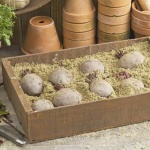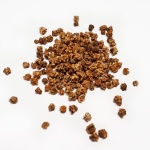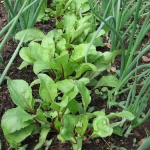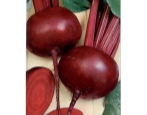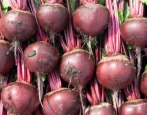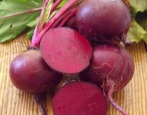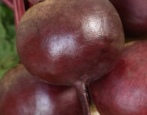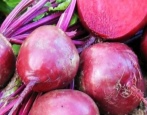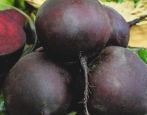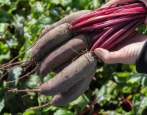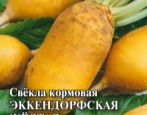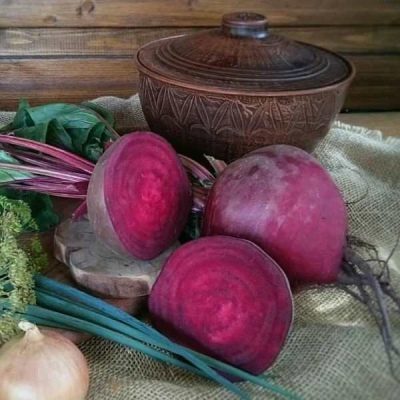
- Authors: Maksimov S.V.
- Year of approval: 2003
- Leaf rosette shape: upright
- Leaves: oval, green, slightly bubbly, slight waviness of the edge
- Petiole: underside purple
- The form: rounded
- Weight, g: 160-360
- Cork head: absent or very weak
- Pulp color : red
- Ringiness: without division into ring zones
Mulatto is a popular beet variety grown in many regions of the Russian Federation. Table beets have almost no drawbacks, and most gardeners are satisfied with the mid-ripening periods.
Breeding history
Despite the fact that the variety appeared in the State Register in 2003, they began to breed it long before that, back in the 80s. The work was carried out under the guidance of S.V. Maksimov, a domestic breeder. He set the task of developing a variety with even root crops that would be convenient to transport. Full success was achieved by 2001, and two years later, the variety was added to the registry list.
Description of the variety
Beetroot Mulatka is a mid-season crop suitable for winter storage. It has excellent indicators of yield, marketability and transportability. An additional advantage of the Mulatto is that there are no white rings in the fruit. This is very attractive for buyers. Plants are resistant to weather whims, not particularly demanding on the composition of the soil. However, lighting is critical in growing. In addition, the described variety is not resistant to all diseases and pests.
Characteristics of the appearance of the plant and root crops
The mulatto has an erect leaf rosette. It is not very large in size. The foliage forms oval, with light waves around the edges. The green surface of the plates is weakly bubbling. As for the cuttings, their bottom is always painted in a purple tone.
It is worth considering the features of the mulatto root crops:
- the shape of the tubers is round, the maximum diameter is 15 centimeters;
- the mass mainly ranges from 160-360 grams, but there are also samples of 400 g;
- dark red skin is smooth;
- the cork structure of the heads is extremely rare, but if it does, it is very weak;
- there are no annular cylindrical zones;
- red pulp has a smooth and juicy texture.
The fruits are distinguished by good sugar content, as they contain from 14.2 to 14.6% sugar.
Purpose and taste of tubers
The tenderness and sweet taste of the pulp have led to the universal use of beets in the farm. It can be safely consumed fresh, as well as sent for culinary processing. It is worth noting that it does not lose brightness because of this. Blanks from Mulatka are widely demanded in winter, as well as in the manufacture of soups, borscht, beetroot juice.
Maturation
A mulatto spends from 90 to 115 days to reach full maturity. The timing is the result of the influence of weather and climate. In any case, this variety is considered mid-season.
Yield
The variety has a very good yield, but this will depend on the region of growth. For example, in the Volga-Vyatka region, gardeners have a chance to get 258-447 centners per hectare, and in the Central Black Earth Region - 249-405. If we talk about the Moscow region, then the results here will be worse - about 200-300 centners.
Growing regions
Mulatto can be cultivated in the Central and Volga-Vyatka regions. It also gives good indicators in the Central Black Earth Region. The situation is a little worse in the Far East, but even there summer residents do not particularly complain.
Growing and care
Vegetable growers who want to get a harvest a month earlier grow beets in a seedling way, but in the overwhelming majority of cases this variety is planted directly in the ground, choosing for this the end of April or the beginning of May. The disembarkation is carried out in shallow grooves, previously watered with water.The distance between the grains is 10 cm. The grooves should be placed 30 cm apart. After backfilling the grains with soil, the soil next to the crops is loosened.
The sprouts that have appeared will require compliance with the rules of agricultural technology. They will definitely need to be thinned out, since each seed usually produces 2 or more shoots. The first thinning is carried out with the development of 2 leaves, the second - after the appearance of the fifth leaf. Thinning should be done carefully, pinching the sprout, and not tearing it out by the root.
Very young seedlings are watered every 2 days, and stronger ones - 2 times every 7 days. It is impossible for the upper layer of the earth to completely dry out. The mulatto is drought-resistant, the plant itself will not die, but its roots will turn out to be bitter and tasteless. This variety is very fond of sprinkling, which is performed after sunset. Having finished with irrigation, the next day the soil is loosened, cleaned of weeds, and a mulching layer is applied to it. Watering should be stopped 14 days before harvesting the beets.
In no case should you feed the Mulatto woman with minerals. This can cause the roots to crack. It is more reasonable in this case to use organic feeding, for example, chicken or mullein. 1.2 liters of solution will be required per square meter of area. All organic matter is served diluted with water. As soon as the foliage closes on the beets, a glass of wood ash is poured onto a square meter of soil, and then good watering is carried out.
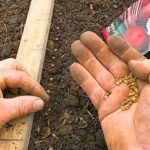
Beetroot tolerates cold snaps, therefore it is widely grown in the open field. When planting beets, you need to correctly determine the sowing time, choose a suitable place, prepare the beds, and do pre-sowing seed treatment.

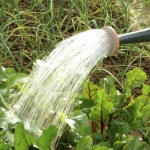
Soil requirements
The mulatto is not too pretentious about the composition of the soil. It will develop harmoniously on both sandy loam and loamy substrates. However, there are two important conditions: the soil must be loose and not waterlogged. In the case of a close occurrence of groundwater, drainage is arranged. Also, acidic soils deacidify before planting. Before planting, humus is introduced into the ground in an amount of 3 kg per square meter, as well as about 40 grams of a suitable mineral mixture with all the necessary components.
Required climatic conditions
In order for the Mulatto to grow well, it must be planted in a sunny area. The ground should be warm, about 10 degrees, and the air temperature should not be lower than 20. The variety does not like cold weather, therefore, planting is carried out only when the night frosts will definitely go away.
Disease and pest resistance
The mulatto resists diseases at an average level. It is resistant to flowering, but susceptible to phomosis and downy mildew. However, it should be noted that such ailments occur only with improper care. The most dangerous disease is black leg, which affects young seedlings.
Of insects, plants can be annoyed by scale insects, flies, aphids. Appetizing root crops are often damaged by bears, and slugs can also be found in too humid areas.

Review overview
Beetroot Mulatto is very often featured in gardeners' reviews, and almost all of them have a positive context. Summer residents have been growing this productive variety for years without finding any particular problems. They are pleased with the yield, smooth presentation of the fruit without cracking, juicy pulp with a sweet taste. Seedlings grow quickly, need minimal care and, if all the rules are followed, do not get sick.
The only thing that gardeners don't really like is the need to feed exclusively with organic matter. Not everyone has it, and many find it more convenient to buy formulations.
